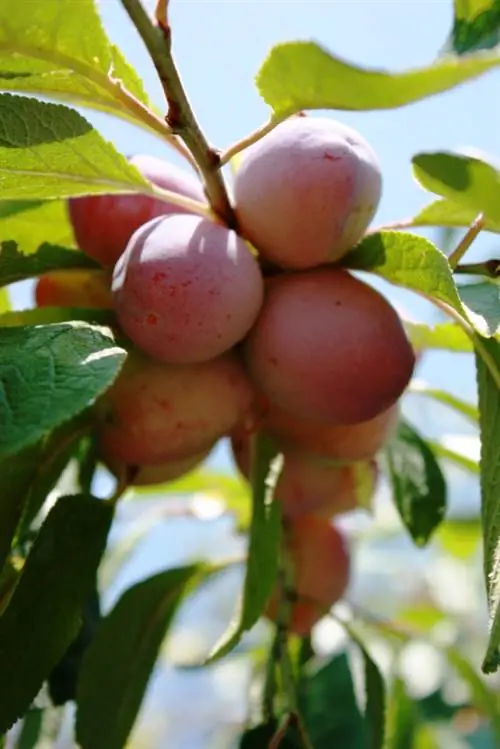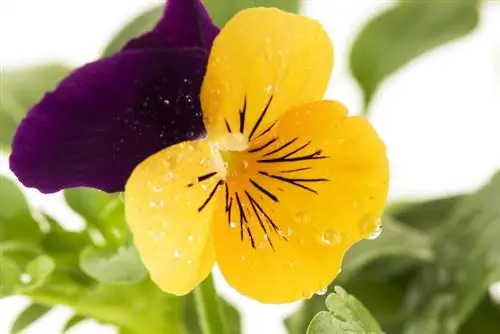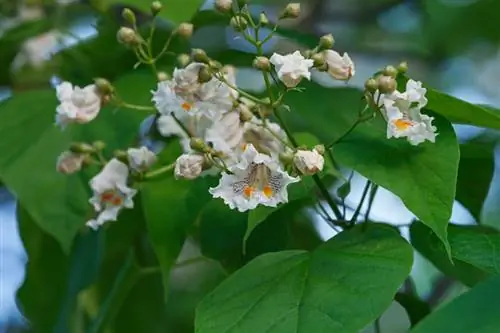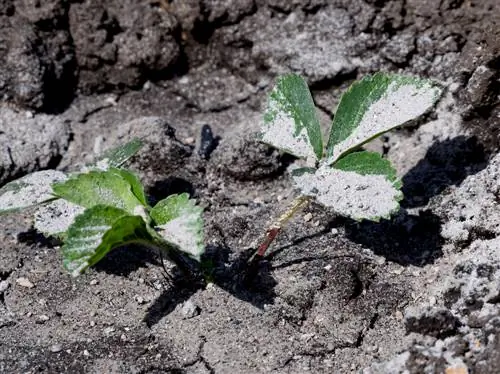- Author admin [email protected].
- Public 2023-12-16 16:46.
- Last modified 2025-06-01 06:02.
So that hydrangeas grow dense and bushy and bloom profusely, you need regular fertilizer. The hydrangea is a bit tricky and not every fertilizer is suitable for supplying the plant with nutrients. You can find out which fertilizer is suitable for the hydrangea and when you should fertilize in this article.
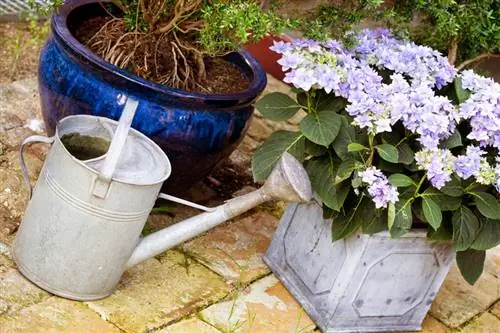
What fertilizer should you use for hydrangeas?
Hydrangeas need regular fertilization with nitrogen-based chemical or organic complete fertilizers that contain little phosphorus. Mineral fertilizers such as special fertilizers for hydrangeas, rhododendrons or azaleas are suitable, as are organic fertilizers such as horn shavings, horn meal, humus and coffee grounds. For blue hydrangeas, also use special fertilizer for blue color.
The nutrient requirements of the hydrangea
Hydrangeas are among the plants that place very specific demands on the soil and have a relatively high nutrient requirement. The bushes need a lot of nitrogen and potassium, as these nutrients have a direct influence on flower formation. In addition, the plants must be adequately supplied with minerals such as iron, sulfur, manganese and zinc, as these are often not present in sufficient quantities in the soil.
Suitable fertilizers
In order to cover the hydrangeas' nutrient requirements, the plants must be fertilized with a nitrogen-based chemical or organic complete fertilizer that also contains little phosphorus. Many commercially available universal fertilizers are unsuitable for flowering plants because the phosphorus content of these products is far too high. In the case of blue hydrangeas, this leads, among other things, to the flowers turning pink or pink again.
Mineral fertilizers: convenient to use
Special mineral fertilizers for hydrangeas are available from well-stocked garden shops. Alternatively, special fertilizers for rhododendrons or azaleas are also suitable. These fertilizers provide the hydrangea with all the nutrients it needs for he althy plant growth and abundant flowering.
Thanks to the fertilizer being well incorporated into the soil, the necessary nutrients are immediately available to the plant. However, this has the disadvantage that the fertilizer effect can wear off after a short time. Only if fertilization is carried out regularly and exactly according to the manufacturer's instructions can an even supply of the plant be ensured.
Special liquid fertilizers for hydrangeas are ideal for feeding potted plants. Fertilize regularly as indicated on the packaging to optimally supply the plant with all nutrients.
Organic fertilizers - the natural alternative
More and more garden lovers want to avoid using chemical fertilizers and therefore prefer to use organic fertilizers. These provide the hydrangea with all the nutrients it needs over a longer period, but require some time to work optimally. For this reason, you must carefully plan the timing of fertilization with organic fertilizers. Organic fertilizers are environmentally friendly and, since many products can be produced yourself, they are an inexpensive alternative to other fertilizers.
Horn shavings and horn meal
These fertilizers consist of cattle horns and cattle claws that have been crushed or ground.
- Horn flour: grain size less than one millimeter
- Horn semolina: grain size of one to five millimeters
- Horn shavings: grain size over five millimeters
The nitrogen content of this fertilizer is around 12 to 15 percent, the phosphorus content is less than one percent. Horn shavings must first be broken down by soil organisms and only decompose slowly. Over-fertilization is therefore almost impossible. For horn meal, the decomposition time is a few days; coarse horn shavings require several months until they are completely broken down.
In order to optimally supply the hydrangea with all nutrients, we recommend applying horn shavings on poor and dry soils in combination with humus.
Humus: Nutrient-rich, deep black compost soil
Humus is a highly effective garden fertilizer that tiny microorganisms produce from garden and green waste. Within a year, properly prepared compost creates a pleasantly fragrant, moist, crumbly and very nutrient-rich substrate that you can work directly into the soil.
Hydrangeas love coffee grounds
Coffee grounds contain many minerals and, when applied regularly, shift the pH value of the soil into the acidic range preferred by hydrangeas. Worms and microorganisms also love coffee grounds, so the soil structure is noticeably improved by this fertilizer.
However, it is not enough to scatter the coffee grounds around the hydrangea. Work the fertilizer well into the soil so that it can develop its full effect.
Special fertilizer turns the flowers blue
Hydrangeas bloom pink, white or red without special fertilization. The coveted blue color only occurs if aluminum compounds and potassium alum are present in the soil and the substrate has a pH value of 4.0 to 4.5.
How to keep your blue hydrangea beautiful:
- Special flower fertilizers for the blue color only work on pink-flowering varieties
- The pH value of the soil must not be above 4.5 (test strips)
- Rhododendron soil can be used to shift the pH value to the desired acidic range.
- Water the hydrangea only with rainwater.
The right time to plant hydrangea blue is spring. Constant doses of fertilizer according to the package instructions are necessary, otherwise the flowers will gradually turn pink again. However, these two-tone flower balls can look very distinctive.
The right time for fertilization
When the days get longer again and the stronger spring sun warms the ground, it is the optimal time to supply the hydrangea with fertilizer for the first time of the year. Loosen the soil around the plants with a digging fork and fold in some humus mixed with horn shavings. Since the horn shavings only decompose slowly, it is sufficient if you fertilize the hydrangea a second time in June.
You can alternatively fertilize outdoor hydrangeas and hydrangeas in pots in spring and early summer with a long-term mineral fertilizer. You should also work some of these fertilizers into the soil.
Smaller potted hydrangeas must be watered regularly with liquid fertilizer once a week during the growing season, which runs from March to August.
All hydrangeas, regardless of whether they grow in containers or outdoors, should only be fertilized until the end of the growing season at the end of August. This is the only way the shoots can fully mature by the start of winter. If fertilization is carried out for too long, sufficient shoot closure is not guaranteed and there is a risk of frost damage.
Do not fertilize hydrangeas with blue seed
Blaukorn is one of the fast-acting complex fertilizers and is relatively inexpensive. The fertilizer contains as much phosphorus as nitrogen and is therefore completely unsuitable for fertilizing hydrangeas. Blue hydrangeas that are fertilized with blue grain turn pink again within a very short time. In addition, blue grain flows very uncontrollably. Therefore, if possible, avoid fertilizing the hydrangea's neighboring plants with blue grain.
Tips & Tricks
Hydrangeas often suffer from chlorosis caused by iron deficiency. This trace element is hardly present in many soils. Iron chelate fertilizer and watering with rainwater can help here.



